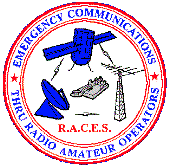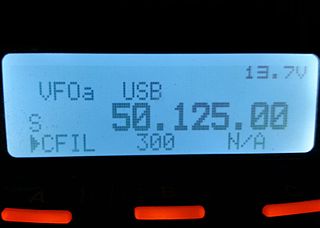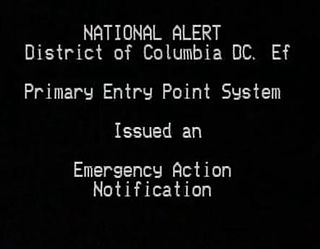Related Research Articles

Radioteletype (RTTY) is a telecommunications system consisting originally of two or more electromechanical teleprinters in different locations connected by radio rather than a wired link. Radioteletype evolved from earlier landline teleprinter operations that began in the mid-1800s. The US Navy Department successfully tested printing telegraphy between an airplane and ground radio station in 1922. Later that year, the Radio Corporation of America successfully tested printing telegraphy via their Chatham, Massachusetts, radio station to the RMS Majestic. Commercial RTTY systems were in active service between San Francisco and Honolulu as early as April 1932 and between San Francisco and New York City by 1934. The US military used radioteletype in the 1930s and expanded this usage during World War II. From the 1980s, teleprinters were replaced by personal computers (PCs) running software to emulate teleprinters.
The Federal Aviation Regulations (FARs) are rules prescribed by the Federal Aviation Administration (FAA) governing all aviation activities in the United States. The FARs comprise Title 14 of the Code of Federal Regulations. A wide variety of activities are regulated, such as aircraft design and maintenance, typical airline flights, pilot training activities, hot-air ballooning, lighter-than-air aircraft, human-made structure heights, obstruction lighting and marking, model rocket launches, commercial space operations, model aircraft operations, unmanned aircraft systems (UAS) and kite flying. The rules are designed to promote safe aviation, protecting pilots, flight attendants, passengers and the general public from unnecessary risk.

Citizens band radio is a land mobile radio system, a system allowing short-distance one-to-many bidirectional voice communication among individuals, using two-way radios operating near 27 MHz in the high frequency or shortwave band. Citizens band is distinct from other personal radio service allocations such as FRS, GMRS, MURS, UHF CB and the Amateur Radio Service. In many countries, CB operation does not require a license and may be used for business or personal communications.
The American Radio Relay League (ARRL) is the largest membership association of amateur radio enthusiasts in the United States. ARRL is a non-profit organization and was co-founded on April 6, 1914, by Hiram Percy Maxim and Clarence D. Tuska of Hartford, Connecticut. The ARRL represents the interests of amateur radio operators before federal regulatory bodies, provides technical advice and assistance to amateur radio enthusiasts, supports a number of educational programs and sponsors emergency communications service throughout the country. The ARRL has approximately 161,000 members. In addition to members in the US, the organization claims over 7,000 members in other countries. The ARRL publishes many books and a monthly membership journal called QST.

The Radio Amateur Civil Emergency Service (RACES) is an emergency radio service authorized in Part 97.407 of the Federal Communications Commission (FCC) rules and regulations governing amateur radio in the United States.
Code of Federal Regulations, Title 47, Part 15 is an oft-quoted part of Federal Communications Commission (FCC) rules and regulations regarding unlicensed transmissions. It is a part of Title 47 of the Code of Federal Regulations (CFR), and regulates everything from spurious emissions to unlicensed low-power broadcasting. Nearly every electronics device sold inside the United States radiates unintentional emissions, and must be reviewed to comply with Part 15 before it can be advertised or sold in the US market.
Radiotelephony procedure includes various techniques used to clarify, simplify and standardize spoken communications over two-way radios, in use by the armed forces, in civil aviation, police and fire dispatching systems, citizens' band radio (CB), and amateur radio.
Station identification is the practice of radio and television stations and networks identifying themselves on-air, typically by means of a call sign or brand name. This may be to satisfy requirements of licensing authorities, a form of branding, or a combination of both. As such, it is closely related to production logos, used in television and cinema alike.

The 6-meter band is the lowest portion of the very high frequency (VHF) radio spectrum internationally allocated to amateur radio use. The term refers to the average signal wavelength of 6 meters.
Modulated continuous wave (MCW) is Morse code telegraphy transmitted using an audio tone to modulate a carrier wave.

High-speed multimedia radio (HSMM) is the implementation of high-speed wireless TCP/IP data networks over amateur radio frequency allocations using commercial off-the-shelf (COTS) hardware such as 802.11 Wi-Fi access points. This is possible because the 802.11 unlicensed frequency bands partially overlap with amateur radio bands and ISM bands in many countries. Only licensed amateur radio operators may legally use amplifiers and high-gain antennas within amateur radio frequencies to increase the power and coverage of an 802.11 signal.

Amateur radio international reciprocal operating agreements permit amateur radio operators (hams) from one country to operate a station whilst traveling in another without the need to obtain additional licenses or permits.

In the United States, amateur radio licensing is governed by the Federal Communications Commission (FCC). Licenses to operate amateur stations for personal use are granted to individuals of any age once they demonstrate an understanding of both pertinent FCC regulations and knowledge of radio station operation and safety considerations. There is no minimum age for licensing; applicants as young as five years old have passed examinations and were granted licenses.
Winlink, or formally, Winlink Global Radio Email, also known as the Winlink 2000 Network, is a worldwide radio messaging system that uses amateur-band radio frequencies and government frequencies to provide radio interconnection services that include email with attachments, position reporting, weather bulletins, emergency and relief communications, and message relay. The system is built and administered by volunteers and is financially supported by the Amateur Radio Safety Foundation.

Broadcast law and Electricity law is the field of law that pertains to broadcasting. These laws and regulations pertain to radio stations and TV stations, and are also considered to include closely related services like cable TV and cable radio, as well as satellite TV and satellite radio. Likewise, it also extends to broadcast networks.

A Volunteer Examiner Coordinator is an organization that has been authorized by the Federal Communications Commission for the administration of amateur radio license examinations in the United States. The VEC system is established and outlined in Part 97 of the FCC rules and regulations.
The 2200-meter or 136 kHz band is the lowest frequency band in which amateur radio operators are licensed to transmit. It was formally allocated to amateurs at the 2007 World Radiocommunication Conference (WRC-07). The band is available on a secondary basis in all ITU regions with the limitation that amateur stations have maximum radiated power of 1 watt effective isotropic radiated power.
The 13 centimeter, 2.3 GHz or 2.4 GHz band is a portion of the UHF (microwave) radio spectrum internationally allocated to amateur radio and amateur satellite use on a secondary basis. The amateur radio band is between 2300 MHz and 2450 MHz, and thereby inside the S-band. The amateur satellite band is between 2400 MHz and 2450 MHz, and its use by satellite operations is on a non-interference basis to other radio users. The license privileges of amateur radio operators include the use of frequencies and a wide variety of modes within these ranges for telecommunication. The allocations are the same in all three ITU Regions.

Amateur radio, also known as ham radio, is the use of the radio frequency spectrum for purposes of non-commercial exchange of messages, wireless experimentation, self-training, private recreation, radiosport, contesting, and emergency communications. The term "amateur" is used to specify "a duly authorized person interested in radioelectric practice with a purely personal aim and without pecuniary interest" ; and to differentiate it from commercial broadcasting, public safety, or professional two-way radio services.

A National Emergency Message, formerly known until 2022 as an Emergency Action Notification, is the national activation of the Emergency Alert System (EAS) used to alert the residents of the United States of a national or global emergency such as a nuclear war or any other mass casualty situation. This alert can only be activated by the president of the United States or a designated representative thereof, such as the vice president. The Emergency Broadcast System (EBS) also carried the Emergency Action Notification. Except for the 2011 national test, which utilized the Emergency Action Notification alert type, no president has ever issued a National Emergency Message.
